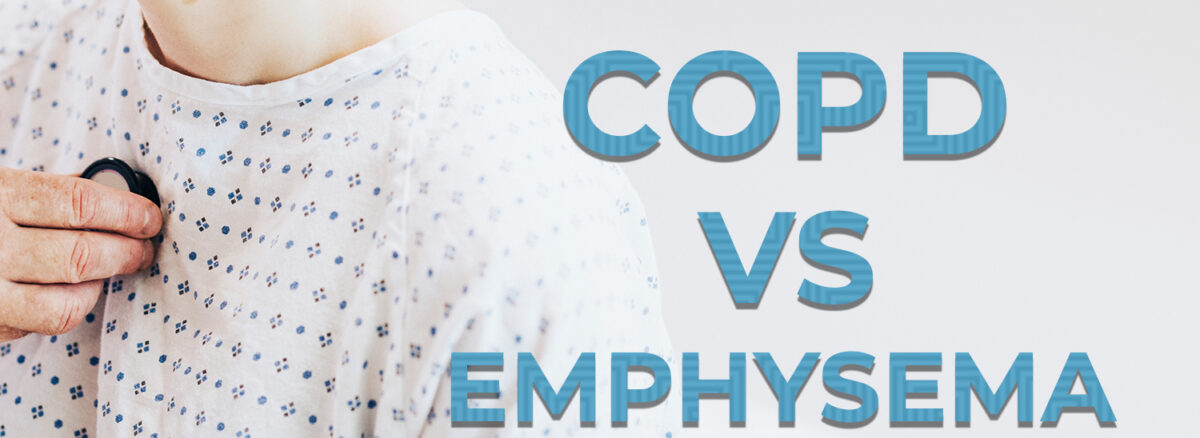COPD VS Emphysema
Isn’t it a common norm to compare diseases if their affected areas are similar? It is, and that’s why we’ve jumped into the discussion of COPD VS Emphysema. Rest assured because you’ll have all your doubts cleared before leaving from here. Without further ado, let’s get into the waters.
What is Emphysema?
Emphysema is a lung disease that begins with tiny gaps between the alveoli that gradually expand to produce bigger holes. People find it difficult to breathe fresh air because old air becomes stuck in these air gaps. While blood flow through the alveoli is impeded, patients with emphysema have difficulties in not just breathing but also inhaling oxygen. Emphysema is more frequent as people get older and, in men; and it runs in families.
What is COPD?
COPD stands for Chronic Obstructive Pulmonary Disease. COPD is a group of lung diseases that damage the lungs, reduce airflow, and make breathing increasingly difficult over time. Although COPD cannot be cured, medications can help to alleviate symptoms and prevent future damage. More than 3 million individuals die each year from COPD, which affects an estimated 174 million people globally. Emphysema is a form of COPD.
What is the difference between Emphysema and COPD?
The main difference between emphysema and COPD is that emphysema is an accelerated lung disease induced by over-inflation of the alveoli (air sacs in the lungs), whereas COPD (Chronic Obstructive Pulmonary Disease) is an umbrella term that describes a group of lung conditions (including emphysema) that are characterized by increasing shortness of breath. COPD is a disease that affects people who have emphysema. Not every person with COPD has emphysema.
Causes of COPD and Emphysema:
- COPD and Emphysema are most commonly caused by years of smoking cigarettes. Its symptoms are more common in adults in their early fifties.
- Long-term exposure to the environment, tobacco, air pollution, chemical odors, and dust are all possible causes.
- COPD and emphysema can also be caused by genetic causes such as an alpha-1-antitrypsin deficiency.
How do doctors identify COPD and Emphysema?
COPD and emphysema are diagnosed using the same tests. The following tests may be performed:
- Your medical history, family medical history, and physical examination
- Alpha-1-antitrypsin level Hematocrit Serum bicarbonate
- X-ray of the chest
- CT Scan of the Chest
- Sputum test
- Blood oxygen in the arteries
- Tests of pulmonary function (FEV1) and staging
Symptoms of COPD and Emphysema:
COPD symptoms, including emphysema, typically don’t show up until the lungs have been severely damaged. In most cases, these symptoms will get worse with time. Signs and symptoms are:
- Cough that lasts for a long time, often known as “smoker’s cough.”
- Breathing problems, especially while doing an activity or going up the stair.
- Unexpected weight reduction
- Mucus production throughout time
- Wheezing
- Ankles, feet, or legs swelling
- A persistent sense of tiredness
Treatment for COPD and Emphysema:
COPD and Emphysema cause irreversible damage to the lungs. Emphysema and COPD can be treated.
- Antibiotics may be administered to patients with these disorders in addition to bronchodilators and inhaled steroids to manage infections.
- To help you breathe better, your doctor may suggest an oxygen concentrator or oxygen generator.
- Lung surgery or even a lung transplant may be necessary for rare situations.
- On polluted days, keep the windows shut. Best to avoid inhaling air pollution dust and smells.
- Making lifestyle changes can help you live more comfortably. It’s possible that changing the way you perform housekeeping, cooking, and other activities can help you feel better.
Conclusion:
The severity of emphysema grows with the severity of COPD and affects the majority of COPD patients. It is a global illness with growing prevalence and health consequences. Emphysema induced tissue damage is thus a key predictor of COPD disease severity. What’s actually needed is a long-term improvement initiative. It’s critical to use clinical predictors to identify people with frequent exacerbation feature.

